Miami Beach boasts the world’s greatest concentration of art deco buildings, which reflect a distinct era in American history—along with the can-do attitude that has defined the nation. From the Great Depression years through the 1940s, architects in the Miami area designed dominantly within the umbrella of styles now known as art deco, and some nine hundred structures in this genre remain. They rose amid economic hard times and evoked technological modernity, resilience, and optimism.
Among the art deco styles characteristic of Miami Beach is Streamline Moderne, distinguished by machine-inspired aerodynamic curves and sleek horizontal forms, lines, and accents. This industrial-looking style emphasizes asymmetrical, U-shaped facades with sweeping, wraparound elements. Many of Miami’s examples reflect the locale with such features as concrete “eyebrows” over windows to shade guests from Florida’s unforgiving sun, round porthole windows, ship-like railings, and other nautical and tropical touches.
Exemplars of Streamline include Commodore Hotel (1360 Collins Ave.) and Essex House (1001 Collins Ave.), both designed by architect Henry Hohauser and built in 1936 and 1938, respectively; and Sherbrooke Hotel (901 Collins Ave.), an E. A. MacKay and Frederick Gibbs design constructed in 1947. All of these resemble luxury ocean liners anchored at street corners.
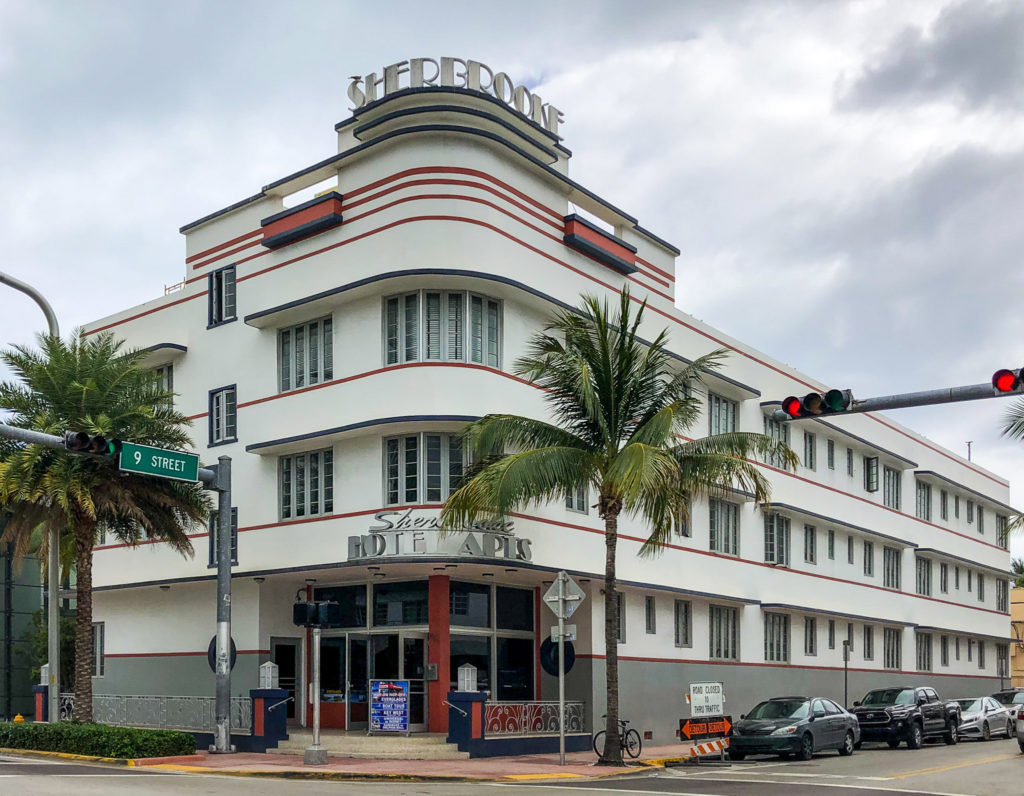
Sherbrooke Hotel. Photo by Joseph Kellard
An exhibit at Miami Beach’s Art Deco Museum reports that Streamline was “buttressed by the belief that times would get better, and was infused with the optimistic futurism extolled at America’s World Fairs of the 1930s.” Elaborating this sentiment, authors Richard and Valerie Beaubien write in their book Discovering South Beach Deco:
America needed a morale-booster during the depression and post-depression years. Moreover, it was time to explore a modern, national identity, instead of looking to European history. The United States was embarking on a technological odyssey. As the thirties progressed, the streamline sleekness of fast cars and trains was reflected in design, from household appliances and furniture to buildings.1
Another prevalent style is tropical art deco, which typically consists of boxy concrete structures with vertical facades partitioned into three sections, often with a dominant, stylized central panel rising above a flat roofline. Standouts include The Cavalier (1320 Ocean Dr.), designed by architect Roy France and built in 1936, The Leslie (1244 Ocean Dr.), and Majestic Hotel (660 Ocean Dr.). The latter two were created by architect Albert Anis and raised in 1937 and 1940, respectively. Other noteworthy examples in the tropical style are Hotel Webster (now a women’s boutique at 1220 Collins Ave.), designed by Hohauser and built in 1939; and The McAlpin (1430 Ocean Dr.), constructed in 1940 and designed by Lawrence Murry Dixon. Between them, Hohauser and Dixon designed about 70 percent of the city’s original art deco structures.
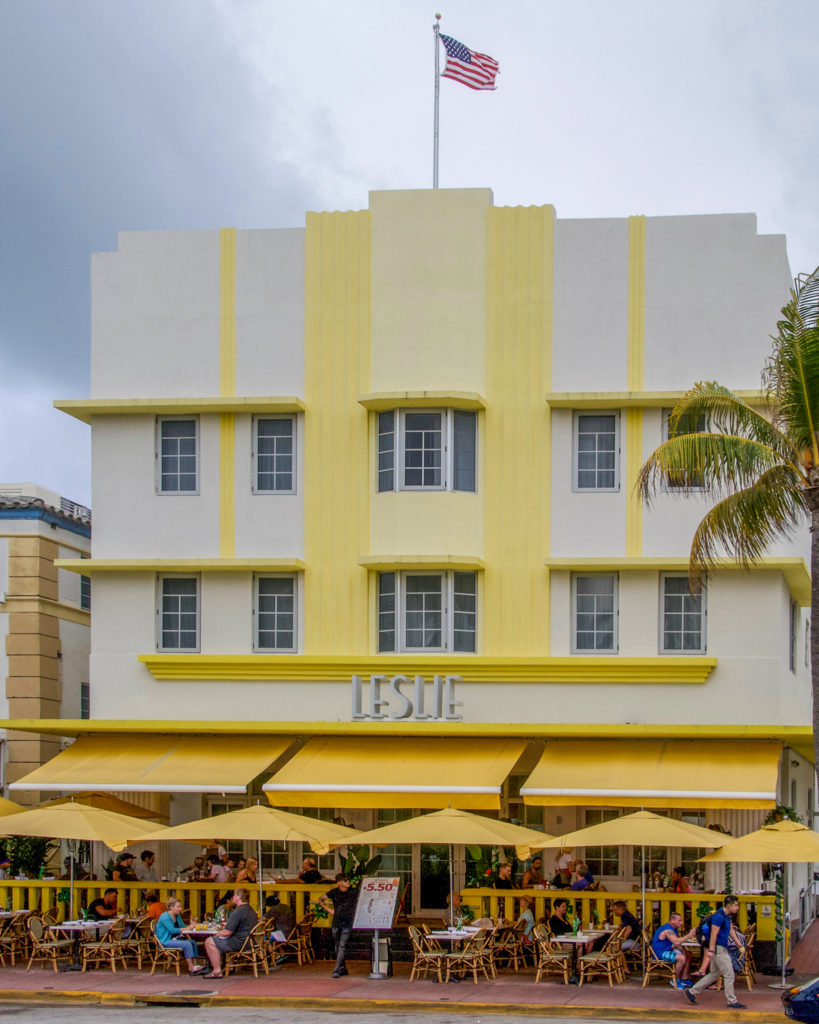
The Leslie. Photo by Joseph Kellard
Defying the Great Depression
A confluence of timely factors led to the proliferation of art deco in Miami Beach. During the early 20th century, Carl Fisher, an automobile industry entrepreneur turned land developer, helped transform what was largely a mosquito-infested sandbar into a stretch of luxury hotels and homes built in the Mediterranean Revival style. The city’s real estate market took a downturn in 1925, the same year Paris hosted a world’s fair that showcased a design style of industrial-centric and geometric forms later called art deco. The next year, the city plunged deeper into economic hard times when a major hurricane slammed South Florida, leaving twenty-five thousand people homeless throughout greater Miami. Post-storm rebuilding was limited and was further impeded by the 1929 stock market crash.
Despite the Depression, Miami Beach generated another development boom just as art deco was entering its heyday in America, popularized by New York’s newly constructed Empire State Building, Chrysler Building, and RCA Building, and Chicago’s Century of Progress Exhibition of 1933–34. In 1930, Miami Beach had sixty-five hundred permanent residents, a figure that doubled within five years as many Northerners migrated south. From roughly 1933 to the time the United States entered World War II in 1941, more than 2,000 homes, 164 hotels, and 485 apartment buildings were constructed in Miami Beach.2 The Beaubiens report:
Just as Miami Beach preceded the nation into depression, so did it precede it into recovery. The next boom began in 1933 and actually peaked in 1936, while the rest of the country was still reeling. In part, the early recovery was due to the Jewish migration that began earlier in the decade. The new property owners were able to build real estate equity ahead of a full economic recovery.3
While local banks and contractors remained cash strapped, these migrants invested heavily in developing their property.
Architects gradually introduced art deco elements, leading to a transitional hybrid now called Med-Deco (Mediterranean plus art deco). Representatives include the Hohauser-designed Edison Hotel (960 Ocean Dr.) and Stiles Hotel (originally called the Primrose, at 1120 Collins Ave.) by architect Victor Nellenbogen. Both were built in 1935 with Mediterranean arches and decorative cornices blended with symmetrical, vertical, tripartite facades suggestive of tropical art deco style. Nellenbogen’s 1934 Franklin Hotel (860 Collins Ave.) sports similar arches and three columns of windows with accents and a central frieze of tropical flowers and leaves, a common art deco motif.
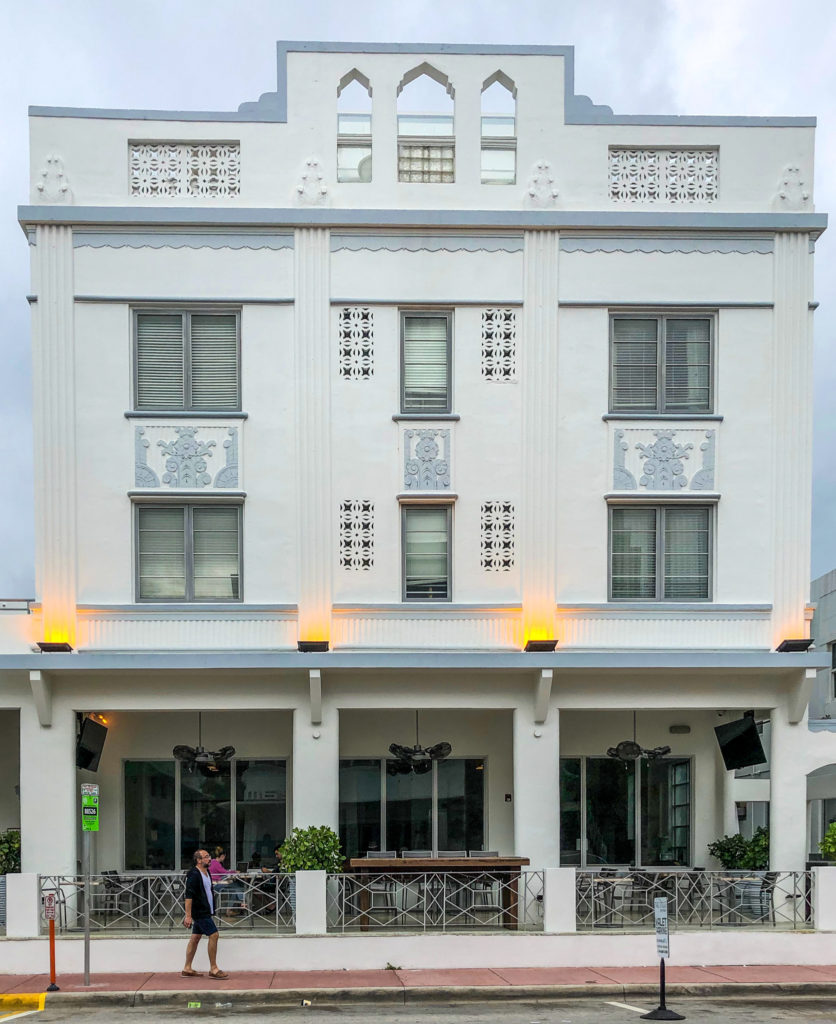
Stiles Hotel. Photo by Joseph Kellard
Most Miami Beach hotels are a blend of styles, of which two 1939 classics by Hohauser are exemplary: the Cardozo Hotel (1300 Ocean Dr.) and Greystone Hotel (1920 Collins Ave.). Although mainly horizontal Streamline designs—with “rounded lines, like the fender of a Studebaker”—Hohauser also incorporated tropical-style vertical panels on each.4 Dixon’s 1937 Victor Hotel (1144 Ocean Dr.) was another influential hybrid. The building’s original asymmetrical tower rose eight stories with sophisticated vertical lines and Streamline-style porthole windows, along with a ship-like rounded dining room.
Many of Miami Beach’s art deco buildings share design elements, such as terrazzo flooring, ziggurat molding, and murals of the Everglades and other Florida landscapes, as well as marble and scagliola, glass and mirrors etched with flamingos and palm trees, fireplaces, wrought-iron railings, space-age pendant lights, Vitrolite, and glass block.
The glass block over the entrance of the Washington Avenue Post Office (1300 Washington Ave.), which was designed in the Deco Federal style by Howard Lovewell Cheney and built in 1937, invites sunlight into the lobby, a domed rotunda with a mural (by Charles Russell Hardman) that includes Ponce de Leon’s encounter with Florida natives in 1513. The 11th Street Diner (1065 Washington Ave.) is a classic dining car of glass block and stainless steel, a material used for lettered signs on many hotels. Hohauser’s classic 1935 three-story Colony Hotel popularized the use of neon lights on marquee signs, now a Miami Beach signature. Today, even a Walgreens store (1400 Collins Ave.)—designed by Robert Brown and Frank Demandt in a style coined Progressive Moderne and built in 2014—sports such an “off-brand” neon sign, along with geometric shapes, porthole windows, and other art deco-era elements.
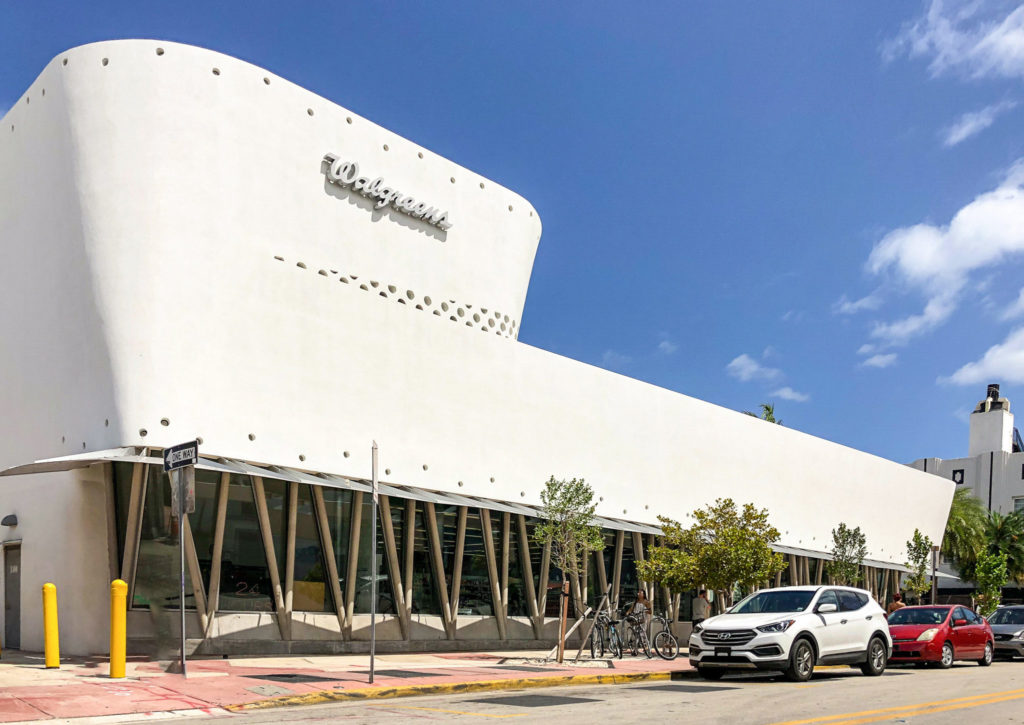
Walgreens (1400 Collins Ave.). Photo by Joseph Kellard
Preservation and Revitalization
By the 1970s, Miami’s art deco buildings were aging. Many were demolished, and others were slated to be. In 1976, Barbara Baer Capitman, a New York transplant, founded the Miami Design Preservation League (MDPL). This nonprofit organization loomed large behind a mix of voluntary and (unfortunately) government-backed measures to keep art deco buildings intact.5
By 1979, South Beach’s art deco neighborhood was listed on the National Register of Historic Places as the Miami Beach Architectural Historic District. Initially, the city adopted nonbinding ordinances that appealed to property owners to maintain their art deco structures as built. As years passed, the city incrementally imposed property-use restrictions that essentially prohibit demolition and exterior alterations and ban new developments from copying original buildings or designing dominantly in art deco-era features—except with the permission of bureaucrats.
Even apart from such property-rights violations, the city’s art deco buildings would have continued to languish if not for many indispensable private investors. These property owners continued maintaining, upgrading, and profiting from their hotels and other commercial buildings. Among the trailblazers were Capitman’s son, Andrew Capitman, a banker whose company purchased, restored, and operated several art deco properties; and the late Tony Goldman, whose real estate firm continues to buy and revitalize properties in rundown neighborhoods.6
Other voluntary preservation efforts include the early 1980s campaign—led by Leonard Horowitz, an interior designer and MDPL cofounder—who convinced many building owners to repaint their drab white-and-beige art deco buildings with vibrant colors that reflect the region’s tropical landscapes and sunsets.7 The newly colorized district served as a regular backdrop for the popular Miami Vice television show during the mid-1980s. The show helped inspire the fashion industry to shoot television and magazine ads amid South Beach’s dazzling scenery, all contributing to a revival that has attracted a cosmopolitan crowd of celebrities, artists, and tourists.8
If you like art deco, visit this unique haven of iconic architectural treasures, along with the city’s Art Deco Museum. You’ll delight in these colorful works of art and find inspiration in the resilience and optimism they embody.
Click To Tweet
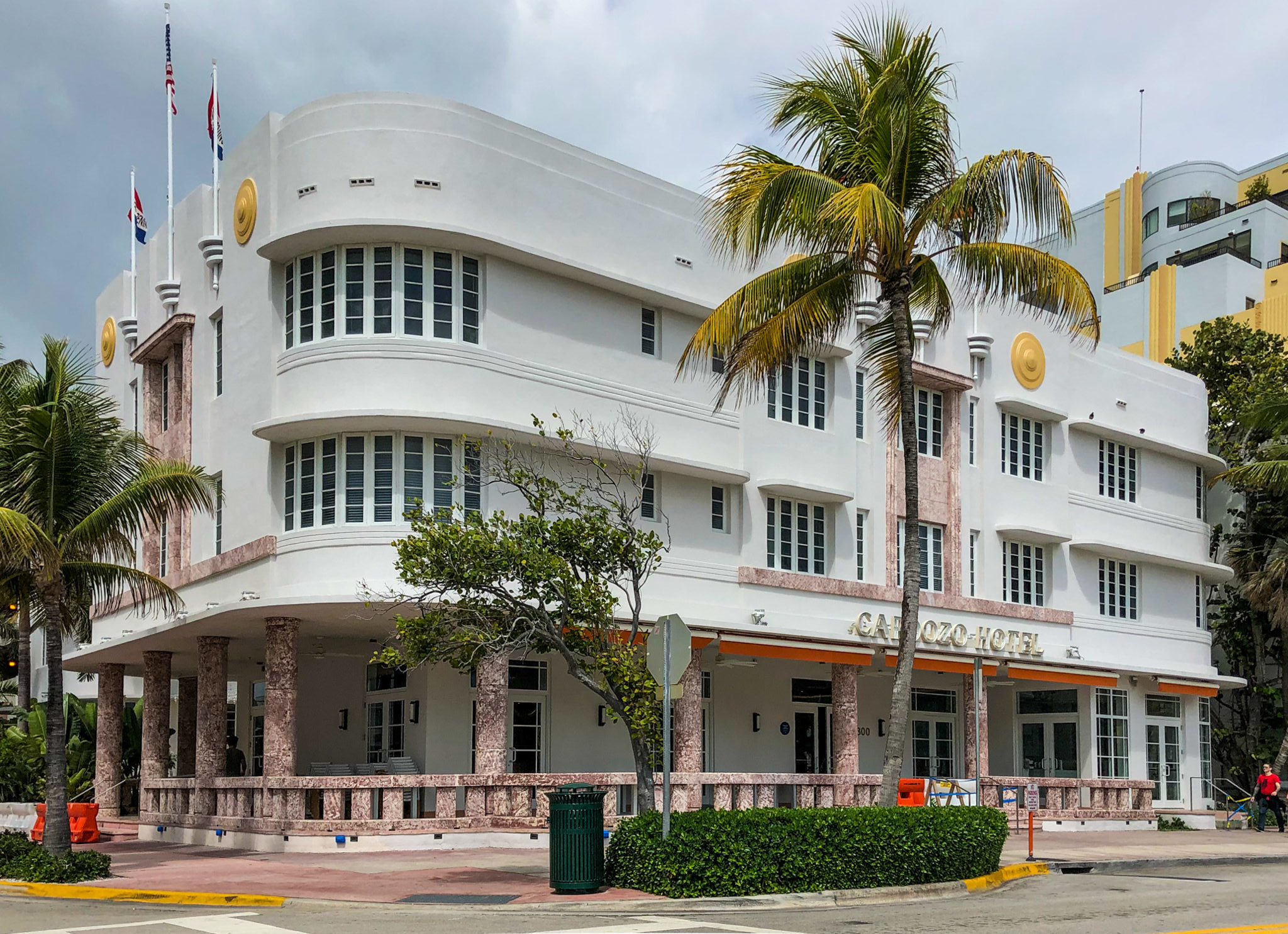
Cardozo Hotel. Photo by Joseph Kellard
You might also like
Endnotes
1. Richard and Valerie Beaubein, Discovering South Beach Deco: Walking Tours in the Miami Beach Art Deco District (Bolton, MA: Domani Press, 2004), 24.
2. Beaubein, Discovering South Beach Deco, 22–23.
3. Beaubein, Discovering South Beach Deco, 23.
4. “The Cardozo Story,” Cardozo South Beach, https://www.cardozohotel.com/about_us/ (accessed February 10, 2020).
5. “A Brief History of MDPL,” Miami Design Preservation League, https://www.mdpl.org/about-us/about-miami-design-preservation-league/a-brief-history/ (accessed February 10, 2020).
6. “Andrew Captiman,” Duff & Phelps, https://www.duffandphelps.com/our-team/andrew-capitman (accessed February 10, 2020); Elinor J. Brecher, Douglas Hanks, and David Smiley, “South Beach, Wynwood Developer Tony Goldman Dies at 68,” Miami Herald, September 12, 2012, https://www.miamiherald.com/news/local/community/miami-dade/midtown/article1942633.html.
7. Brooke Blackhurst, “Tropical Deco: The History of Miami’s Pastel Hues,” HedgeApple, August 2, 2018, https://hedgeapple.com/blog/2018/8/2/tropical-deco-the-history-of-miamis-pastel-hues/; Laura Stewart Dishman, “Designer Helps Miami Beach Add Some Color into Its Chic,” Orlando Sentinel, January 15, 1987, https://www.orlandosentinel.com/news/os-xpm-1987-01-15-0100140146-story.html.
8. Andres Viglucci, “The Vice Effect: 30 Years after the Show That Changed Miami,” Miami Herald, September 28, 2014, https://www.miamiherald.com/news/local/community/miami-dade/article2266518.html.


![[TEST] The Objective Standard](https://test.theobjectivestandard.com/wp-content/uploads/2017/10/logo.png)













